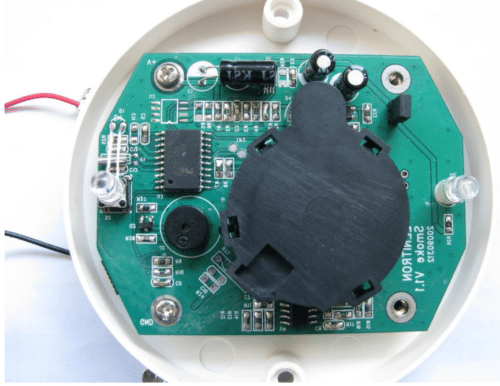The advanced smoke detector design features a photoelectric sensor, high-decibel alarm, and low power consumption, all powered by a sophisticated microcontroller for reliable fire detection.

The reference design from Cypress serves as a smoke detector designed to detect fires. It utilizes a photoelectric sensor to detect infrared radiation refracted by smoke or dust particles produced by fire. Key features of this demo set include a high-decibel alarm, battery operation, and low power consumption.
The smoke detector features a high-decibel alarm that exceeds 70 dB within a 3m range, ensuring adequate coverage of a 60 square meter area when mounted less than 5m above the floor. It is powered by two batteries, operating at a 1.8 V to 3.3 V DC voltage range.
The design features a low battery output warning; the DC-DC converter monitors battery capacity and signals the MCU to trigger an alert. When low battery output occurs, the buzzer sounds, and the LEDs flash simultaneously. Additionally, the detector has an automatic alarm function; it senses refracted light reflecting the thickness of smoke or dust. Stronger light indicates a higher risk of fire. When the thickness of smoke or dust reaches a threshold, the red fire alarm light flashes first, followed by the buzzer sounding for 11 seconds.
This design’s microcontroller unit (MCU) is the MB95F202K from Cypress’s MB95200 series. Its features include 4 KB of FLASH memory and 240 bytes of RAM. It offers four clock resources: a main oscillator, a sub-oscillator, a ceramic resonator, and a sub-ceramic resonator. Additionally, it has two channels of 8/16-bit timers and a LIN module that supports both primary and slave modes. The MCU also provides six channels for 8/10-bit ADC and features low-voltage detection (LVD).
The DC-DC boost converter maintains a constant power output of 3.3 V when the battery voltage falls below 3V. The EMH7600 boost converter, which supports an input range of 0.3 V – 6 V and provides a 3.3 V output, has been chosen. It can deliver an output current of up to 500 mA. Efficiency is a critical factor for this component.
The design features a photoelectric detector with an IR-emitting diode and an IR-receiving diode. The IR-receiving diode is positioned within a dark cavity. An amplifier circuit is required to amplify the signal for the subsequent analog-to-digital (AD) stage. The current is converted to voltage before reaching the amplifier.
Reducing power consumption is crucial in battery-powered systems, both from a firmware and hardware perspective. Implementing a sleep mode with periodic wake-ups is a common strategy to lower power usage, and this design also employs this method.
Cypress has tested this reference design. It comes with a Bill of Material (BOM), schematics, etc. You can find additional data about the reference design on the company’s website. To read more about this reference design, click here.




